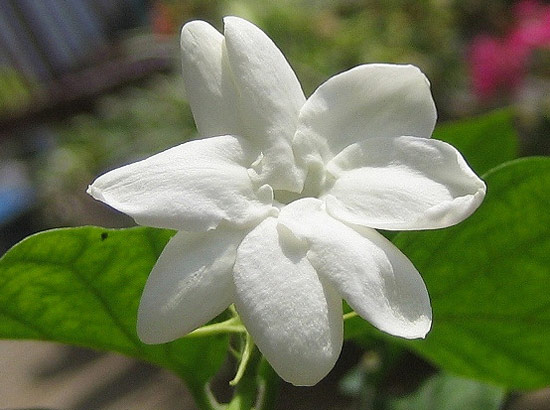National Symbols: National Flower
Sampaguita (common name)
Jasminum sambac (scientific name)
Designation
Official
Also Known As
Philippine jasmine, Sambac jasmine, Arabian jasmine, mogra, pikake, melati putih
Classification
- Kingdom: Plantae
- Division: Magnoliophyta
- Class: Eudicots
- Order: Lamiales
- Family: Oleaceae
- Genus: Jasminum
- Species: J. sambac
The Flower
Sampaguita flowers bloom on a very small shrub. Buds are oval and pale yellow-green. Open flowers are small, waxy, star-like, pure white and very fragrant. Most sampaguita flowers have eight to 10 long, oval petals that open flat from a corolla tube about 1-1.5 cm (.5 in) long; some varieties, however, have multiple curled petals. The flower's two stamens and slender stigma are contained in the corolla tube and are not prominently displayed. The flowers usually open at night; they fall in less than a 24-hour period. Flowers bloom in clusters at the ends of branches, usually in threes, but sometimes in groups of up to 12. Stems are gray-brown and woody, though new shoots are supple and bright green. Leaves are pointed ovals, thin, papery, slightly crinkled and prominently ribbed. A fertilized flower produces a round, dark berry.
Physical Details
Duration: Perennial
Plant: Small shrub.
Mature Height: 1 m (3 ft)
Flowering: June-September
Flowers: 2.5 cm (1 in) across in clusters of three to 12 flat, waxy flowers
Flower Color: White
Leaves: 6-7.5 cm (2.5-3 in) long, pointed, oval medium to deep green leaves.
Fruit / Seed Color: Dark purple / brown.
Habitat
Location: Sunny, well-drained locations with good moisture in frost-free areas.
Range: Native to Asia, including India, Myanmar and Sri Lanka. Now widely cultivated in frost-free areas worldwide.
Trivia
- The species name sambac comes from the Sanskrit word champaka, which is paradoxically the name of a different fragrant flower. The name sampaguita is the Spanish rendition of the Tagalog words sumpa kita, which mean I promise you. In the Philippines, sampaguita is a symbol of purity, constancy, honor, loyalty, strength and dignity. These flowers probably came to the Philippines from northern India in the 17th century, and soon were well-established. The sampaguita became the Philippines' national flower in 1934 under the rule of American Governor-General Frank Murphy, former mayor of Detroit. Sampaguitas are employed for leis or used for corsages, wreaths or ceremonial crowns.
- Sampaguita flowers are depicted on the Filipino Seal of the Senate. Six blooms flank the seal's shield on each side, together representing the county's 12 regions. The flowers also symbolize characteristics attributed to the Senate: strength, dignity and honor.
- An essential oil can be distilled from sampaguita flowers; this may be used as a fragrance by itself, or as a base for other perfumes.
- In traditional medicine, sampaguita roots were used to treat wounds, particularly snake bites.
Copyright © 1993—2025 World Trade Press. All rights reserved.

 Philippines
Philippines 
